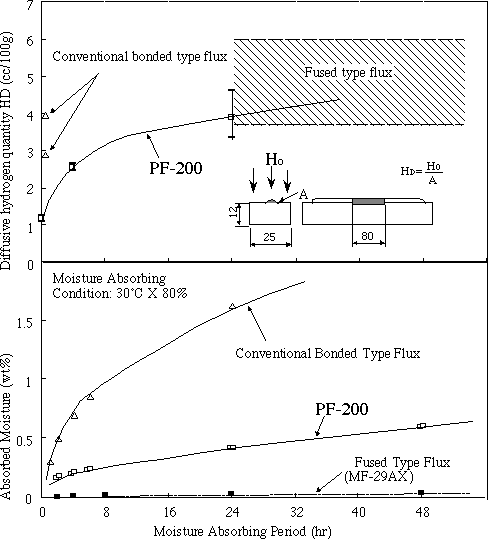Home > Products > Energy & Chemical Field > Pressure Vessels > Kobe Steels welding materials
 Kobe Steels welding materials
Kobe Steels welding materials
Ultra low hydrogen type bonded flux (PF-200 and PF-500) and its features
![]()
Indispensable to the manufacture of high performance pressure vessels is the welding material. Kobe Steel is a world famous manufacturer of welding materials, and has succeeded in the development of an ultra low hydrogen bonded flux (PF-200 and PF-500), which is intended for use in submerged arc welding of Cr-Mo steels. The use of PF-200 and PF-500 allows a substantial reduction in the amount of hydrogen in the weld metal. Kobe Steel had already developed a low temperature postweld heat treatment technique (DHT) that enabled the omission of intermediate stress relief (ISR), which had been believed indispensable to the prevention of low temperature delayed cracks, and have long been using this method to manufacture many pressure vessels. Now, application of the ultra low hydrogen bonded flux has further raised the reliability of the DHT. The PF 200 is being used for the conventional 2 1/4Cr-1Mo steel, and PF-500 is being used for the modified steels (2 1/4Cr-1Mo-V).
Types of fluxes and diffusible hydrogen in weld metal
![]()
The fluxes for submerged arc welding can be classified into three types according to the manufacturing methods: Fused, Sintered, and Bonded. Among them the moisture absorption characteristics are different, therefore, they influence the amount of diffusible hydrogen in the weld metal. Although each of the fluxes absorbs moisture in a wet atmosphere, as time passes their absorption level is larger in the order of Fused < Sintered < Bonded. On the other hand, comparing the fluxes for the amount of diffusible hydrogen in the weld metal, which increases in proportion to the amount of moisture absorbed, the order runs Bonded < Fused < Sintered. Although Bonded flux has the highest moisture absorption, it contains some carbonate which resolves to generate carbon dioxide during welding operation, thus, in the arc atmosphere, the hydrogen pressure which is the source of hydrogen intrusion into the weld metal, is lowered.
Moisture absorption characteristics of PF-200 and PF-500 and diffusible hydrogen
![]()
As explained above, the bonded flux can keep the amount of diffusible hydrogen in the weld metal low. However, the flux absorbs moisture readily and strict controls are required. With the PF-200 (PF-500), moisture absorption has been substantially improved. The figure below shows the moisture absorption characteristics of PF-200 and amount of diffusible hydrogen. Compared with the existing bonded flux, the moisture absorption amount is smaller, and the amount of diffusible hydrogen, even after the flux was kept in a wet atmosphere for 24 hours after drying out, is smaller than that with the low hydrogen type fused flux immediately after drying out.

Figure: Moisture absorption characteristics of PF-200 and diffusible hydrogen



